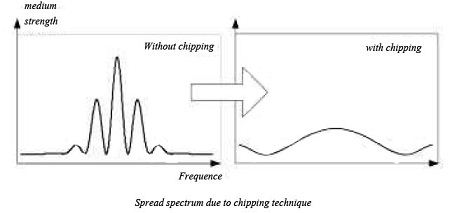The DSSS (Direct Sequence Spread Spectrum) is a technique spread spectrum, but unlike the FHSS, no frequency hopping is place: DSSS causes very rapid state transitions (chipping) which tend to spread the spectrum of the signal: in fact, we have seen that with the modulations FSK, PSK and QAM width of the spectrum was twice the rate of the source. Causing “artificially” very high throughput, spectrum is spread.
To do this, the transmitter sends a sequence of several bits, called chips, for each information bit to be transmitted. For example, we may choose to send 11101 instead of 0 and its inverse (00010) instead of one: in this case, if one wants to transmit information 010, then we will issue the following chips: 11101 00010 11101. In this example, the 11101 sequence is called the “spreading code”. Over this code, the longer the flow is artificially multiplied, so more spectrum is spread. For example, if the flow of data to be sent is 1 Mb / s, but we uses a spreading code of 11 chips, then the chips flow will of course be equal to 11 Mb / s: suddenly, the frequency band occupied by the signal will have a width equal to 22 MHz because the width of the band occupied by the signal is equal to twice the speed of source. Without chipping the occupied band would have only a width of 2 MHz (two After 1 Mb/s).

We’ll be covering the following topics in this tutorial:
DSSS has two important interests:
• First, as we have said, the signal spectrum is spread, with all the advantages (and disadvantages) that this brings, especially better resistance to noise;
• in that it emits several chips for each bit of information means that can have a significant redundancy that corrects errors transmission. For example, in the previous example, since the receiver knows the spreading code used (11101) then he knows he should receive than 11101 (for the information bit 0) or 00010 (for bit 1). If it receives 00110, it can easily correct the error in considering that the nearest is 00010 (corresponding to bit 1).
802.11 identified fourteen channels of 22 MHz wide, in the same strip of frequencies in the 2.4 GHz FHSS. To communicate, the transmitter and receiver must agree on a fixed channel to use. A flow rate of 1 Mb / s, the 802.11 DSSS modulation based on 2DPSK we saw the 2 Mbit / s DSSS simply uses the 4DPSK modulation.
In both cases, the spreading code has a length of 11 bits and it is always equal to 10110111000. This code is part of a family of codes to mathematical properties Similar defined in 1953 by the mathematician Barker: they promote a good spread spectrum (as would not do, for example, the code 11111111111) and format makes them well suited to synchronize the transmitter and the receiver, which limits problems due to multipath.
CCK modulation
To achieve data rates of 5.5 Mb / s or 11 Mb / s, the further improved the 802.11b process using the modulation Complementary Code Keying (CCK) to reach the so-called high-speed or high-rate DSSS DSSS (HR-DSSS). This one still based on the same basic principle spreading by chipping with 4DPSK modulation. However, instead of always using the same code for Barker spread the signal, it uses up to 64 different codes, which can be transported 6 information bits (because 26 = 64) in addition to the two bits allowed by the modulation 4DPSK. These codes of 8 bits in length each, are “complementary codes” that is to say, their mathematical properties allow receivers not confused, even if there is some transmission errors and even an offset in the reception due to multipath. Since there is significantly less redundancy, it gets more flow, at least as good reception (so short distance). Since the resistance to multipath is better, HR-DSSS is best suited for indoor and short distances on the DSSS Barker.
Unfortunately, when the FHSS can jump congested channels of noise or interference, DSSS can not: If there are other wireless networks operator near the same channel, DSSS will suffer greatly. knowing that Bluetooth technology is based on the FHSS on the same frequencies to 2.4 GHz we understand why the 802.11 DSSS suffers from the presence of Bluetooth devices near. However, Bluetooth support about the presence of equipment 802.11 DSSS. To summarize, the DSSS supports more homogeneous noise (noise “White”) that the FHSS and vice versa, the FHSS better support focused noise on a particular frequency as the DSSS.
As with FHSS, the standard defines for the DSSS a coping mechanism automatic flow depending on the distance. Thus, short modulation HR-DSSS will be 11 Mb / s (8-bit information to 8 chips issued). Moreover, further, one automatically to 5.5 Mb / s (4 bits of information for 8 chips issued). Then, down to 2 Mb / s using the DSSS / 4DPSK Barker and then to 1 Mb / s DSSS / Barker and 2DPSK.
 Dinesh Thakur holds an B.C.A, MCDBA, MCSD certifications. Dinesh authors the hugely popular
Dinesh Thakur holds an B.C.A, MCDBA, MCSD certifications. Dinesh authors the hugely popular